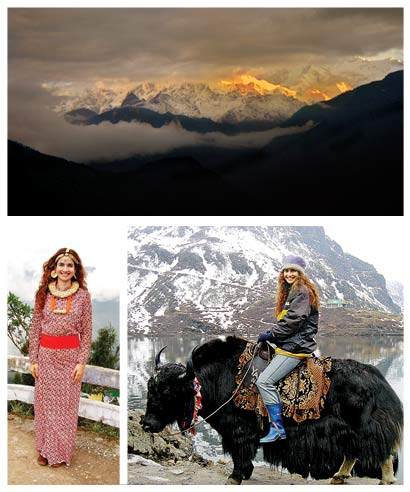 |
(Top) A spellbinding view of the mountains around Sikkim and (below) Sushma Reddy in traditional Sikkimese costume before getting sporty on a yak back!
|
It’s really hard to zero in on the “last frontiers” of India, especially if you are using my parameters, which can be summed up in three words: Virgin, quiet and clean. Inaccessibility has a major role to play in protecting a paradise. Hence, for me, the Lakshadweep, Andaman-Nicobar, Uttarakhand, the Seven Sisters of the North East and Sikkim, are Paradise Found.
A few years ago, I bumped my way from Bagdogra to Gangtok, getting into Sikkim’s busy capital at midnight. Gangtok proved to be disappointing, and I ambled around looking for a hotel among the many perched dangerously on the edge of small cliffs. The flash downpour at night, with the dazzling lightning show, and the low lying clouds wafting through my room reinforced my belief that I would be washed away!
The next morning, my Sikkim jaunt began in earnest: I went to Rumtek Monastery, less to see the beautiful monastery, and more to unabashedly gawk at the image of my teenage crush, the Karmapa, the in-absentia head of Rumtek.
I first set off eastwards towards Changu Lake. The ascent to Changu was stunning, with snowed-in embankments, steep curving roads and looming peaks. Changu Lake, with it’s still-water reflections of the peaks, was unforgettable, as was my first yak ride around the lake. The final ascent to see the magnificent mountain ranges flanked on two sides by India and China, and to watch the Chinese patrols was a once-in-a-lifetime experience.
There is something to be said for the 4 am sunrise that bathes the peak of Kanchenjunga in a golden halo. The peaks felt like they were rising in my back garden! I also undertook the long, hilly walk in West Sikkim to the Rabdentse Ruins. The ruins were excellent, and my head was literally in the clouds.
Next, I wound my way to Yuksam, the starting point for the Dzongri trek, at the edge of the Kanchenjunga National Park. I threw dirty glances at the trekkers preparing in the village on the way, jealous that I wasn’t going with them. Instead, I was being driven to the beautiful Dubdi Monastery, which entailed a mini trek to the top of a small hill. I also went to the Khecheopalri Lake, sacred to both the Hindus and the Buddhists. It was quiet and serene as I entered the pier lined with Tibetan prayer flags and bells, and I filled a few bottles withholy waters to take back with me.
The Sikkimese are warm people. The population consists of Nepalese, Lepchas, Bhutias and the Lachung people. I am a country girl at heart, and totally enjoy good old country living. The North of Sikkim is stunningly wild and inaccessible. I had the good fortune of staying at a Lachung homestay, shovelling in copious quantities of hot dal and rice (the cold and the fresh country air really builds an appetite!), and never really leaving the kitchen, the warmest place in the house!
The Doma, the grandmother or the big boss of the house, made sure I was comfortable, and even offered me fresh chaang beer made from fermented millet drunk with a bamboo straw. Yumthang valley was beautiful, the ground covered with frost and tiny colourful flowers trying to peep out. I spent my time in this haven, drinking salty yak tea, and eating chhurpi, a soft cheese made from yak’s milk. The homestays served the most delicious meals, while in other parts of Sikkim, I subsisted on hot momos and the outstanding Nepali thalis!
No comments:
Post a Comment